4.5E: Exercises for Section 4.5
- Last updated
- Sep 6, 2022
- Save as PDF
- Page ID
- 112083
( \newcommand{\kernel}{\mathrm{null}\,}\)
1) If c is a critical point of f(x), when is there no local maximum or minimum at c? Explain.
2) For the function y=x3, is x=0 both an inflection point and a local maximum/minimum?
- Answer
- It is not a local maximum/minimum because f′ does not change sign
3) For the function y=x3, is x=0 an inflection point?
4) Is it possible for a point c to be both an inflection point and a local extremum of a twice differentiable function?
- Answer
- No
5) Why do you need continuity for the first derivative test? Come up with an example.
6) Explain whether a concave-down function has to cross y=0 for some value of x.
- Answer
- False; for example, y=√x.
7) Explain whether a polynomial of degree 2 can have an inflection point.
In exercises 8 - 12, analyze the graphs of f′, then list all intervals where f is increasing or decreasing.
8)
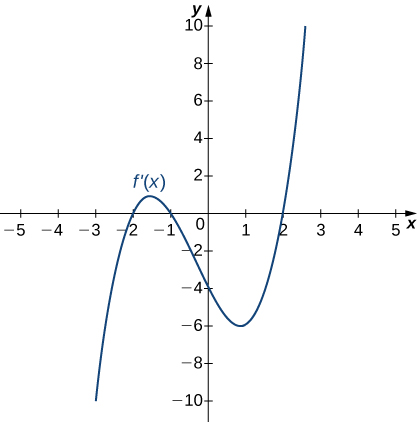
- Answer
- Increasing for −2<x<−1 and x>2;
Decreasing for x<−2 and −1<x<2
9)
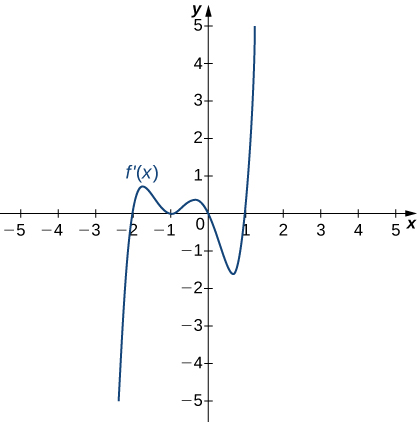
10)
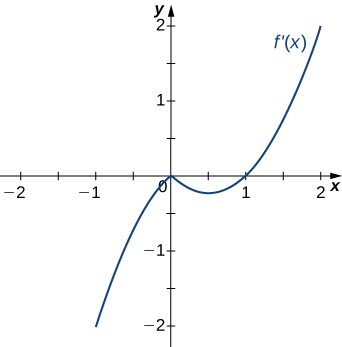
- Answer
- Decreasing for x<1,
Increasing for x>1
11)
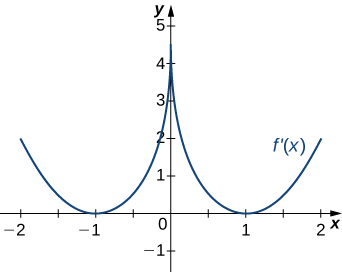
12)
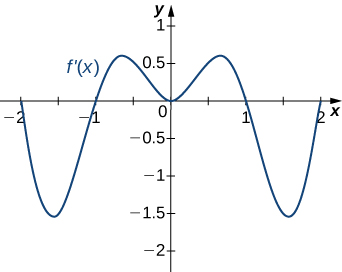
- Answer
- Decreasing for −2<x<−1 and 1<x<2;
Increasing for −1<x<1 and x<−2 and x>2
In exercises 13 - 17, analyze the graphs of f′, then list all intervals where
a. f is increasing and decreasing and
b. the minima and maxima are located.
13)
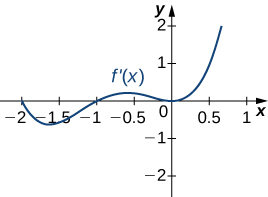
14)
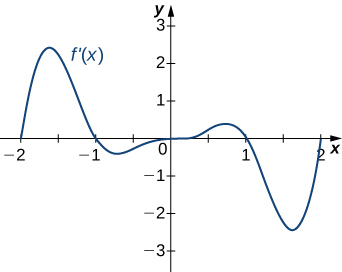
- Answer
- a. Increasing over −2<x<−1,0<x<1,x>2, Decreasing over x<−2,−1<x<0,1<x<2;
b. Maxima at x=−1 and x=1, Minima at x=−2 and x=0 and x=2
15)
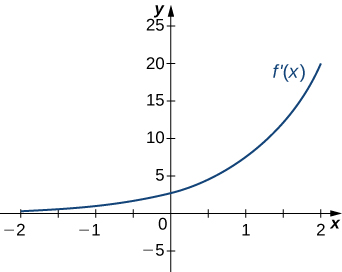
16)

- Answer
- a. Increasing over x>0, Decreasing over x<0;
b. Minimum at x=0
17)
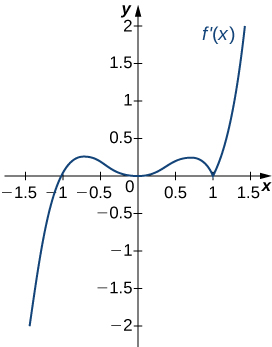
In exercises 18 - 22, analyze the graphs of f′, then list all inflection points and intervals f that are concave up and concave down.
18)
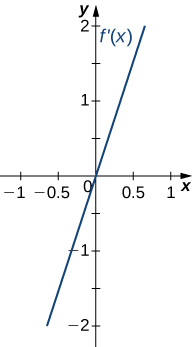
- Answer
- Concave up for all x,
No inflection points
19)
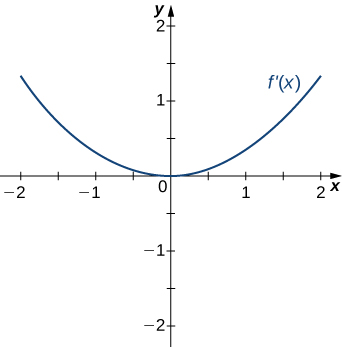
20)

- Answer
- Concave up for all x,
No inflection points
21)
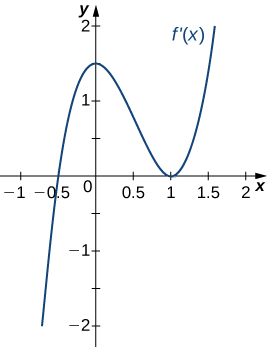
22)
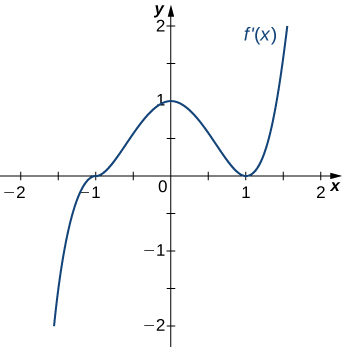
- Answer
- Concave up for x<0 and x>1,
Concave down for 0<x<1,
Inflection points at x=0 and x=1
For exercises 23 - 27, draw a graph that satisfies the given specifications for the domain x=[−3,3]. The function does not have to be continuous or differentiable.
23) f(x)>0,f′(x)>0 over x>1,−3<x<0,f′(x)=0 over 0<x<1
24) f′(x)>0 over x>2,−3<x<−1,f′(x)<0 over −1<x<2,f″(x)<0 for all x
- Answer
- Answers will vary
25) f″(x)<0 over −1<x<1,f″(x)>0,−3<x<−1,1<x<3, local maximum at x=0, local minima at x=±2
26) There is a local maximum at x=2, local minimum at x=1, and the graph is neither concave up nor concave down.
- Answer
- Answers will vary
27) There are local maxima at x=±1, the function is concave up for all x, and the function remains positive for all x.
For the following exercises, determine
a. intervals where f is increasing or decreasing and
b. local minima and maxima of f.
28) f(x)=sinx+sin3x over −π<x<π
- Answer
-
a. Increasing over −\frac{π}{2}<x<\frac{π}{2}, decreasing over x<−\frac{π}{2},\; x>\frac{π}{2}
b. Local maximum at x=\frac{π}{2}; local minimum at x=−\frac{π}{2}
29) f(x)=x^2+\cos x
For exercise 30, determine
a. intervals where f is concave up or concave down, and
b. the inflection points of f.
30) f(x)=x^3−4x^2+x+2
- Answer
-
a. Concave up for x>\frac{4}{3}, concave down for x<\frac{4}{3}
b. Inflection point at x=\frac{4}{3}
For exercises 31 - 37, determine
a. intervals where f is increasing or decreasing,
b. local minima and maxima of f,
c. intervals where f is concave up and concave down, and
d. the inflection points of f.
31) f(x)=x^2−6x
32) f(x)=x^3−6x^2
- Answer
- a. Increasing over x<0 and x>4, decreasing over 0<x<4
b. Maximum at x=0, minimum at x=4
c. Concave up for x>2, concave down for x<2
d. Inflection point at x=2
33) f(x)=x^4−6x^3
34) f(x)=x^{11}−6x^{10}
- Answer
- a. Increasing over x<0 and x>\frac{60}{11}, decreasing over 0<x<\frac{60}{11}
b. Maximum at x=0, minimum at x=\frac{60}{11}
c. Concave down for x<\frac{54}{11}, concave up for x>\frac{54}{11}
d. Inflection point at x=\frac{54}{11}
35) f(x)=x+x^2−x^3
36) f(x)=x^2+x+1
- Answer
- a. Increasing over x>−\frac{1}{2}, decreasing over x<−\frac{1}{2}
b. Minimum at x=−\frac{1}{2}
c. Concave up for all x
d. No inflection points
37) f(x)=x^3+x^4
For exercises 38 - 47, determine
a. intervals where f is increasing or decreasing,
b. local minima and maxima of f,
c. intervals where f is concave up and concave down, and
d. the inflection points of f. Sketch the curve, then use a calculator to compare your answer. If you cannot determine the exact answer analytically, use a calculator.
38) [T] f(x)=\sin(πx)−\cos(πx) over x=[−1,1]
- Answer
- a. Increases over −\frac{1}{4}<x<\frac{3}{4}, decreases over x>\frac{3}{4} and x<−\frac{1}{4}
b. Minimum at x=−\frac{1}{4}, maximum at x=\frac{3}{4}
c. Concave up for −\frac{3}{4}<x<\frac{1}{4}, concave down for x<−\frac{3}{4} and x>\frac{1}{4}
d. Inflection points at x=−\frac{3}{4},\;x=\frac{1}{4}
39) [T] f(x)=x+\sin(2x) over x=[−\frac{π}{2},\frac{π}{2}]
40) [T] f(x)=\sin x+\tan x over (−\frac{π}{2},\frac{π}{2})
- Answer
- a. Increasing for all x
b. No local minimum or maximum
c. Concave up for x>0, concave down for x<0
d. Inflection point at x=0
41) [T] f(x)=(x−2)^2(x−4)^2
42) [T] f(x)=\dfrac{1}{1−x},\quad x≠1
- Answer
- a. Increasing for all x where defined
b. No local minima or maxima
c. Concave up for x<1; concave down for x>1
d. No inflection points in domain
43) [T] f(x)=\dfrac{\sin x}{x} over x=[-2π,0)∪(0,2π]
44) f(x)=\sin(x)e^x over x=[−π,π]
- Answer
- a. Increasing over −\frac{π}{4}<x<\frac{3π}{4}, decreasing over x>\frac{3π}{4},\;x<−\frac{π}{4}
b. Minimum at x=−\frac{π}{4}, maximum at x=\frac{3π}{4}
c. Concave up for −\frac{π}{2}<x<\frac{π}{2}, concave down for x<−\frac{π}{2},\;x>\frac{π}{2}
d. Inflection points at x=±\frac{π}{2}
45) f(x)=\ln x\sqrt{x},\quad x>0
46) f(x)=\frac{1}{4}\sqrt{x}+\frac{1}{x},\quad x>0
- Answer
- a. Increasing over x>4, decreasing over 0<x<4
b. Minimum at x=4
c. Concave up for 0<x<8\sqrt[3]{2}, concave down for x>8\sqrt[3]{2}
d. Inflection point at x=8\sqrt[3]{2}
47) f(x)=\dfrac{e^x}{x},\quad x≠0
In exercises 48 - 52, interpret the sentences in terms of f, f', and f''.
48) The population is growing more slowly. Here f is the population.
- Answer
- f>0,\;f'>0,\;f''<0
49) A bike accelerates faster, but a car goes faster. Here f= Bike’s position minus Car’s position.
50) The airplane lands smoothly. Here f is the plane’s altitude.
- Answer
- f>0,\;f'<0,\;f''>0
51) Stock prices are at their peak. Here fis the stock price.
52) The economy is picking up speed. Here f is a measure of the economy, such as GDP.
- Answer
- f>0,\;f'>0,\;f''>0
For exercises 53 - 57, consider a third-degree polynomial f(x), which has the properties f'(1)=0 and f'(3)=0.
Determine whether the following statements are true or false. Justify your answer.
53) f(x)=0 for some 1≤x≤3.
54) f''(x)=0 for some 1≤x≤3.
- Answer
- True, by the Mean Value Theorem
55) There is no absolute maximum at x=3.
56) If f(x) has three roots, then it has 1 inflection point.
- Answer
- True, examine derivative
57) If f(x) has one inflection point, then it has three real roots.

